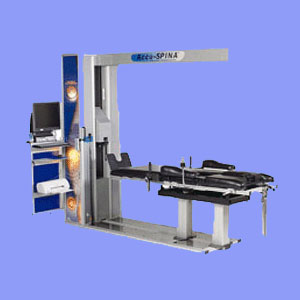
AccuSpina for sciatica is a method of nonsurgical spinal decompression which may be utilized to successfully resolve some forms of compressive neuropathy conditions in the lower back and some forms of spinal stenosis, as well. The AccuSpina device is manufactured by The North American Medical Corp. and uses the IDD (Intervertebral Differential Dynamics) decompression system.
This article profiles the AccuSpina system of decompression and how it is useful in resolving sciatica caused by most disc-related and some bone-related issues. We will examine the positive and negative aspects of the IDD decompression system.
What is Intervertebral Differential Dynamics?
AccuSpina, like other popular forms of spinal decompression, is a machine which enacts highly specific spinal stretching and expansion of the intervertebral disc spaces within the affected painful regions. The device can precisely target any vertebral level which is burdened by a painful herniated disc, degenerative disc disease or some forms of spinal osteoarthritis.
The machine is very gentle and slowly elongates the spine to relieve pressure on pinched nerves due to foraminal stenosis, as well as creating a vacuum effect which helps to coax bulging discs back into their proper anatomical placements.
AccuSpina decompression is also very effective at relieving central spinal stenosis enacted by soft tissue pathologies, such as intervertebral herniations.
AccuSpina for Sciatica Decompression Therapy
The AccuSpina program is advantageous over many other forms of sciatica treatment, since it is finite and offers an excellent chance for a permanent cure without surgery. Most other treatment options are symptomatic in nature and must be continued year after year in order to provide ongoing relief.
Spinal decompression using AccuSpina typically takes about 1 month to complete. AccuSpina recipients will usually receive 20 to 25 sessions on the machine over the course of about 35 days. These sessions last about 30 minutes each and might be supplemented by other healing modalities, such as ice or heat, hydrotherapy, massage or TENS treatment.
The cost of spinal decompression is not cheap, but the therapy still represents a good value when compared to most long-term care options. Basically, it costs more upfront, but is far less expensive over time, since it is a short-term, finite duration therapy.
AccuSpina for Sciatica Opinions
I am an advocate of spinal decompression for indicated, spinally-motivated back pain conditions. There are few risks and the potential to find a real cure. All the major systems including the AccuSpina, the Vax-D and the DRX9000 are well tolerated and well received by most patients. Their effectiveness is hard to deny.
If you have been diagnosed with a disc or facet joint condition which has not responded to conservative therapy options, it might be wise to consider undergoing a regimen of spinal decompression. This treatment is especially indicated for patients who are thinking about undergoing sciatica surgery. Remember, surgery is a huge risk, whereas decompression is statistically more effective and far less hazardous.
Sciatica > Spinal Decompression for Sciatica > AccuSpina for Sciatica




